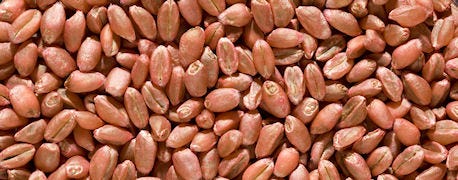March 17, 2014

South Dakota State University has some new research on spring wheat seeding rates.
It was conducted in eastern South Dakota.
"This research showed a seeding rate of 1.2 million pure live seeds (PLS) per acre maximized yields in three out of four years (Figure 1)," says Nathan Mueller, SDSU Extension agronomist. "The 2.3 bushels per acre increase in yield in 2012 would have covered the cost of increasing the seeding rate from 1.2 to 1.8 million PLS per acre in that particular year. However, averaged over the last four years, profit per acre was slightly reduced by increasing seeding rates above the 1.2 million PLS per acre."

Wheat seed is valuable. SDSU conducted several years of trials to determine the best seed rating to use.
Assuming an average germination of 95% viable seed and purity of 99%, the 1.2 million PLS per acre (28 PLS per square foot) equates to a 1.3 million seeds per acre. However, during the study, seed size varied from 12,812 to 26,374 seeds per pound, which Mueller said can change the planting rate from 1.69 bushels to 0.82 bushels per acre to achieve the same number of seeds per acre.
SDSU Seed Testing Lab and other labs offer germination (viable seed), purity, and seed count services to help growers achieve their targeted seeding rates.
"Informal surveys suggest most growers are currently closer to the 1.5 to 1.8 million PLS per acre seeding rate," he says. "The updated seeding rate recommendations based on this recent study will leave the previous recommended seeding rates unchanged."
Similar to soybeans, Mueller said wheat has the ability to flex components of yield to achieve equal yield with less plants.
"In this recent study, components of yield such as heads per live seed planted, heads per square foot, seeds per head, and seed size were measured to help explain the adjustments spring wheat plants can make under a range of plant populations," Mueller says.
As seeding rate increased, the number of heads per live seed planted decreased, and therefore the number of heads per square foot were very similar at 60 to 61 heads. At lower seeding rates, plants increased the number of seeds per head and produced larger seeds.
"With good seedbed conditions and normal planting dates, 1.2 million PLS per acre will achieve equal yields as higher seeding rates because spring wheat plants can adjust yield components (heads per plant, seeds per head, seed size) with the resources available," Mueller says.
Averaged over the last four years, the research showed profit per acre was slightly reduced by increasing seeding rates above the 1.2 million PLS per acre.
For more information about this spring wheat seeding rate study, contact Mueller, [email protected].
To learn more about services available at the SDSU Seed Testing Lab, visit http://www.sdstate.edu/ps/seed-lab/index.cfm.
Source: SDSU
You May Also Like




